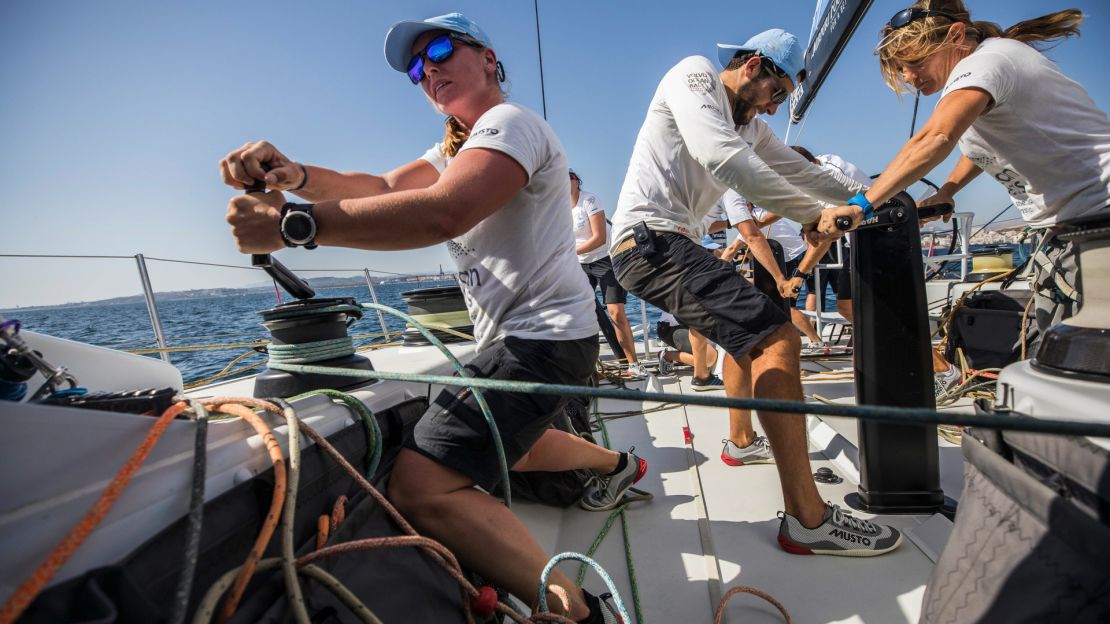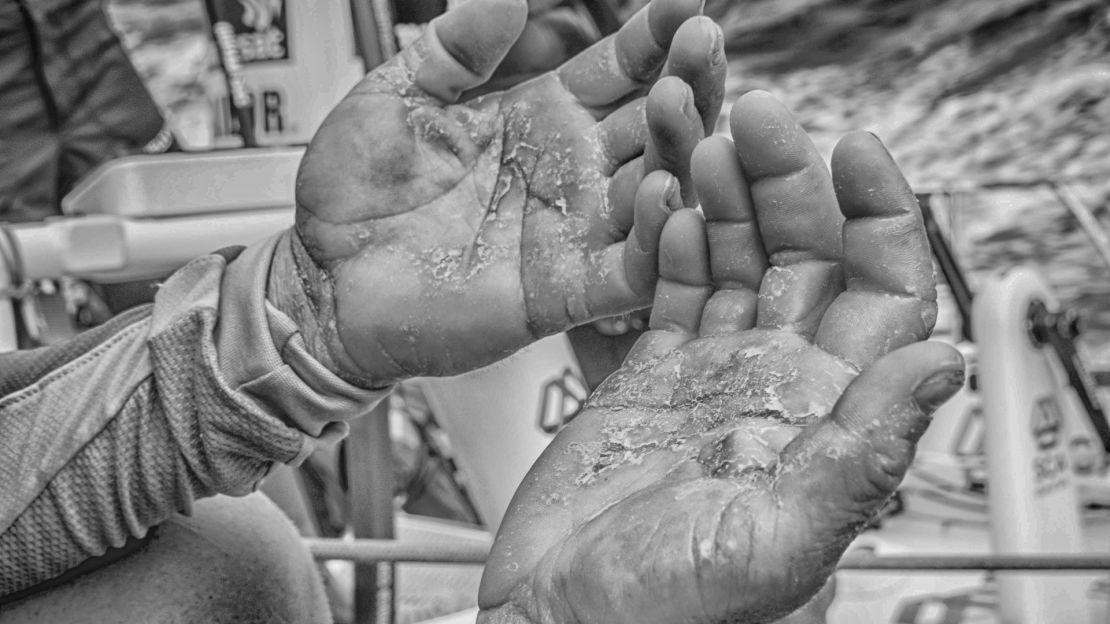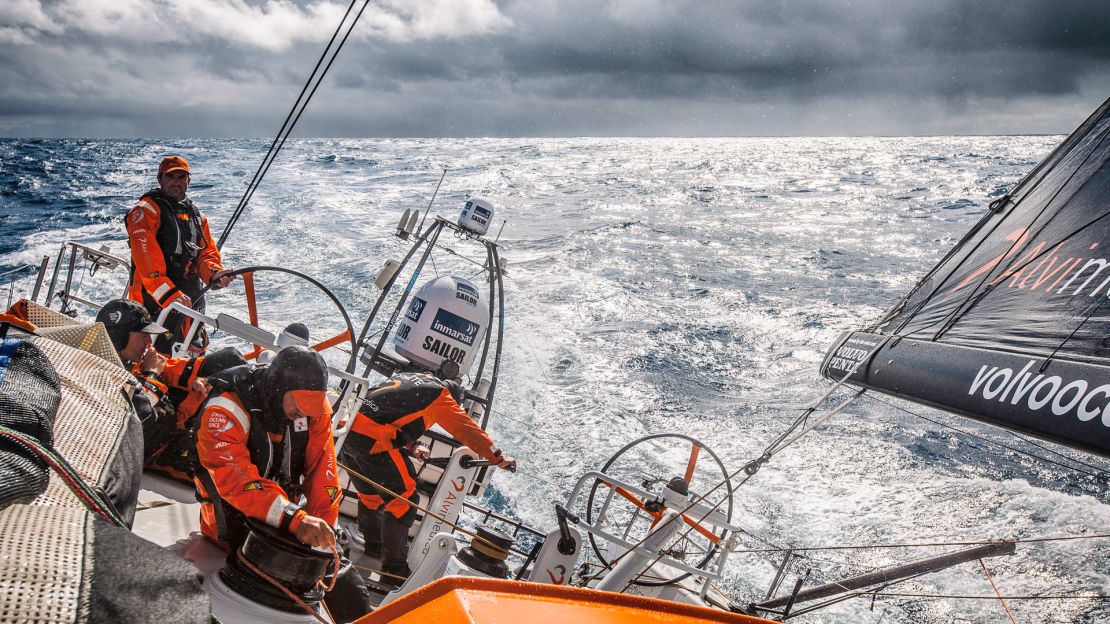Relationships between men and women in the work place have never been under more scrutiny.
However, one leading female sailor Dee Caffari is confident her equally gender split crew is the way forward as it competes in one of the world’s toughest races.
This year’s edition of the Volvo Ocean Race – the premier around-the-world sailing event for professionals – gives a numerical advantage to crews comprised of men and women.
Briton’s Caffari is the only skipper to opt for a 50-50 split, meaning she will race with a crew of 10 aboard the “Turn The Tide on Plastic” boat during the 45,000 nautical mile race.
READ: Bullied as a kid, this sailor conquered the world
“From my experience it helps level out the testosterone in the guys and it brings on the girls,” says Caffari, whose crew set sail from Alicante, Spain last weekend.
“You can’t wuss out, you don’t want to let [the others] down and you have to deliver, so you get a very nice environment to sail in.”
The rule change for this edition of the race reduced the size of an all-male crew from eight to seven, although one or two women can be added. Crews can also contain seven women and one or two men, or five men and five women, or 11 women.
It’s a change that initially didn’t go down well with one of the race competitors.
Rival skipper David Witt, of Hong Kong-based entry SHK Scallywag, vowed to buck the trend of the other six teams and take just seven men and no women, saying: “It’s hard enough to win the race, the last thing we need is to be part of a social experiment.”
However, the veteran Australian skipper has since relented and drafted in Dutchwoman Annemieke Bes to bolster his crew.
READ: Giving it all up to sail around the world
‘Initial hump’
The argument for more sailors is down to rest and recovery times and increased muscle for physically demanding maneuvers such as sail changes.
For Caffari, a mixed crew makes complete sense.
“Most boardrooms are not male-only or female-only, they’re very mixed to produce high-performance teams. My argument was, what’s the difference?” she says.
“What it will achieve, finally, because it’s still an unbelievably male-dominated sport, is it will get us over that initial hump where professional male sailors realize it’s not that bad. Going forward it will be more acceptable and won’t be such a ‘thing.’
“You’re a sailor on the boat because of your ability rather than what gender you are.”

READ: People think we’re crazy, says around-the-world sailor
The 44-year-old Caffari was the first woman to have sailed single-handed around the world in both directions – including the 2009 Vendee Globe – and the only woman to have raced non-stop around the world three times.
She sailed on the all-female Team SCA in the last edition of the Volvo Ocean Race in 2014/2015, her fifth circumnavigation, but has also sailed extensively with mixed crews.
“The conversation is a little cleaner, maybe a bit more polite – but only at times. Girls can often be worse than the guys. It brings out the better side of people,” she says.
“That interaction of having the mix is a healthier environment.”

In Caffari’s experience, gender is unrelated to how individuals cope when the pressure is on during an ocean race.
“Someone who is tired, and nice and warm in their bunk and you want them to go out where it’s wet and cold, they’re all pretty miserable,” she says.
“Either you’re a person that can be woken up four times a day or you’re not. I think whether you’re male or female is irrelevant.”

‘Massive responsibility’
The bulk of Caffari’s crew, including British America’s Cup sailor Bleddyn Mon, has never been to the treacherous Southern Ocean – with its howling winds, huge seas and icebergs – which features in three of the 11 legs from Alicante to The Hague.
“My biggest burden of responsibility going into this race is the level of inexperience on my crew. That’s a massive responsibility for me,” says Caffari.
“Six out of 10 have never been in the Southern Ocean before and don’t know what they don’t know, so don’t even know what to ask. I’m trying to think of everything they need to understand before we go.”
Surfing down mountainous waves with the boat humming at high speed, strong winds screaming through the rigging and sheets of spray lashing across the deck like a fire hose is what draws Caffari back to the world’s watery wastes.
She hopes her excitement for the extreme conditions of the Southern Ocean can rub off on her young crew, especially if they are anxious.
“That’s the best sailing, I love it,” she says. “That’s the bit we signed up for, that’s the cool bit where it gets fun and the sailing is awesome.
“You lead by example. If you’re relaxed and enjoying it and laughing that it is cold and wet then they pick up on that vibe. If you’re stressed and scared and think something terrible is going to happen, that’s the impression they get.”

‘Emotionally battered’
Caffari has learned from experience not to panic, but she still shudders at the memory of being stuck halfway up the mast while making repairs during a solo passage in the Southern Ocean, when the wind had relented from a constant 40 knots for two weeks to a “lighter” 25-30 knots.
“My first reaction was I’ll just cry but clearly that’s not going to help you go up or down,” she says.
“I was trying to psyche myself up to have the confidence to unclip and free climb down. It took me an hour and a half to sort myself out. I didn’t handle it well. I was emotionally battered and bruised and valued myself a bit more after that.”
Even worse was her first brush with an ice field during her groundbreaking “wrong way round” voyage against the prevailing winds in 2005-2006.
Vendee Globe: Images from Conrad Colman's epic voyage
READ: Overboard – 1,000 miles from land
Initially, she was excited and took loads of photos and sent video back to her shore team, but after days on constant ice watch she was on her “last ounces of commitment.”
“I hadn’t slept, hadn’t eaten properly and stress levels were high,” she said. “I thought, ‘I’m done unless I get out of here.’
“It took three days to clear the icefield. That was probably the best day of my life.”
Visit CNN.com/sailing for more news, features and videos
“They’ve got loads of energy. I’ve just got to harness that enthusiasm.”



























